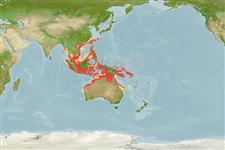>
Eupercaria/misc (Various families in series Eupercaria) >
Nemipteridae (Threadfin breams, Whiptail breams)
Etymology: Nemipterus: Greek, nema, -atos = filament + Greek, pteron = wing, fin (Ref. 45335).
More on authors: Quoy & Gaimard.
Environment: milieu / climate zone / depth range / distribution range
Ecologia
marinhas demersal; não migratória; intervalo de profundidade 10 - 80 m (Ref. 9785). Tropical; 27°N - 28°S, 93°E - 165°E (Ref. 3810)
Western Pacific: Andaman Sea to the Solomon Islands.
Tamanho / Peso / Idade
Maturity: Lm ? range ? - ? cm
Max length : 23.0 cm SL macho/indeterminado; (Ref. 108462); common length : 15.0 cm SL macho/indeterminado; (Ref. 9785)
Espinhos dorsais (total) : 10; Raios dorsais moles (total) : 9; Espinhos anais: 3; Raios anais moles: 7. Suborbital spine absent. Preopercle with 3 transverse scale rows. Pectoral fins long, reaching to or beyond level of anus. Pelvic fins very long, reaching to or just beyond level of anus. A line drawn up from posterior edge of suborbital reaching the dorsal profile at about 2 to 6 scale rows before origin of dorsal fin. Upper lobe of caudal fin slightly longer than lower, tipped with yellow. Females predominate at small sizes, males at larger sizes. Axillary scale present. Color: Upper body pinkish, silvery white below.
Occurs on mud or sand bottoms. Most abundant in depths of 20 to 50 m. Feeds mainly on small shrimps, squid, small fishes and benthic animals.
Life cycle and mating behavior
Maturities | Reprodução | Spawnings | Egg(s) | Fecundities | Larvas
Females predominate at small sizes and males at larger sizes as result of faster growth rates in males.
Russell, B.C., 1990. FAO Species Catalogue. Vol. 12. Nemipterid fishes of the world. (Threadfin breams, whiptail breams, monocle breams, dwarf monocle breams, and coral breams). Family Nemipteridae. An annotated and illustrated catalogue of nemipterid species known to date. FAO Fish. Synop. 125(12):149p. Rome: FAO. (Ref. 3810)
Categoria na Lista Vermelha da IUCN (Ref. 130435)
Ameaça para o homem
Harmless
Utilização humana
Pescarias: pouco comercial
Ferramentas
Relatórios especiais
Descarregue XML
Fontes da internet
Estimates based on models
Preferred temperature (Ref.
123201): 25 - 29, mean 28.1 °C (based on 1040 cells).
Phylogenetic diversity index (Ref.
82804): PD
50 = 0.5000 [Uniqueness, from 0.5 = low to 2.0 = high].
Bayesian length-weight: a=0.01445 (0.01202 - 0.01738), b=2.97 (2.93 - 3.01), in cm total length, based on LWR estimates for this species (Ref.
93245).
Nível Trófico (Ref.
69278): 3.9 ±0.3 se; based on diet studies.
Generation time: 1.4 (1.1 - 2.3) years. Estimated as median ln(3)/K based on 12
growth studies.
Resiliência (Ref.
120179): Elevada, tempo mínimo de duplicação da população menor que 15 meses (K=0.4-0.6).
Fishing Vulnerability (Ref.
59153): Low vulnerability (19 of 100).
Nutrients (Ref.
124155): Calcium = 525 [123, 997] mg/100g; Iron = 1.51 [0.47, 4.18] mg/100g; Protein = 17.8 [16.1, 19.4] %; Omega3 = 0.28 [0.13, 0.62] g/100g; Selenium = 36 [14, 111] μg/100g; VitaminA = 17.3 [4.1, 98.1] μg/100g; Zinc = 0.781 [0.446, 2.664] mg/100g (wet weight);
